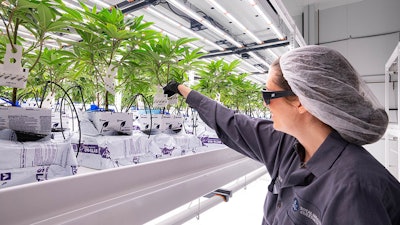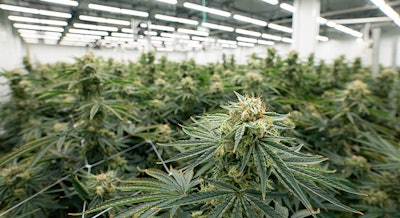
Launched in 2013 by vintner Shannon Walters, LightSky Farms (aka LSF) is a Michigan-based cannabis cultivation company whose products have become synonymous with flavor and quality in the Great Lakes State.
Taking inspiration from his wine-making approach, Walters installed a “flavor-first” ethic to LSF’s cultivation practices. “It wasn't about pushing a lot of weight or things of that nature,” Brooke Widener, LSF’s IPM coordinator, tells Cannabis Business Times. “It was about providing a super memorable and enjoyable experience for people that they're going to always remember.”
LSF got its start under the Michigan caregiver program before transitioning to the Metrc market in 2018 following a partnership with the Landaal family, which operates Landaal Packaging Systems in Flint. With more than 40 cannabis industry awards under its belt, including a score of High Times’ Cannabis Cups and three first-place trophies at this year’s Michigan Zalympix, LSF’s focus has been creating memorable experiences with superior products. And it all starts with a quality grow.
Flavor-First Grow
LSF’s flavor-first approach is all about increasing the natural production of aromatics like terpenes and flavonoids through environmental manipulation, Widener explains. For example, LSF employs controlled dry back farming techniques used in wineries–practices Widener is familiar with as she leveraged dry farming practices at the cannabis farm she owned and operated prior to joining LSF.
“Dry farming and controlled dry backs help boost cannabinoids and terpenes because you’re stressing the plant,” she says. “Certain stresses will even make the plants express terpenes or cannabinoid profiles that it typically wouldn't express if it was never stressed or put under certain conditions.
“So, in a sense, we're manipulating the plants by our practices in order to achieve higher numbers … as opposed to what it would just do naturally.”
While borrowing from traditional wine-making techniques, LSF also takes the opportunity to collect data on its grow and how different inputs affect plant outcomes.
“One thing that we do that I love so much here is we collect a lot of data,” Widener says. “We collect data every single day because there's someone here every single day taking care of the plants.” LSF collects data on watering rates as well as fertigation runoff to determine what tweaks to their in-house nutrient recipes are needed.
Lighting also is closely monitored through daily light meter checks. “Our flower lead
Through data collection and analysis, LSF is discovering the preferred PPFD ranges of their plant varieties, allowing team members to make informed decisions on the fly, like tuning lighting intensity across certain room zones or on specific fixtures. “We’ve found out that certain strains that we have like a lot of light,” she says, “so we try to increase the amount of PPFD that those particular strains are getting.”

LightSky Farms 85,000-square-foot cultivation facility in Michigan. Photo courtesy of Brandon Bailey, Conscious Creations
Being able to tune the lighting intensity is important for LSF to grow its crops to their fullest genetic potential, as lighting can drastically impact the final product’s appearance (especially when selling high-grade flower). For example, chicken fingers, or foxtailing, can be caused by multiple different factors, but lighting can be a catalyst in exposing those shortfalls or additional stressors.
LEDs Make Cents
LSF has navigated the ups and downs of the regulated cannabis world by maintaining a focus on getting “good, safe, quality products in [consumers’] hands,” Brittany Hertzberg, LSF’s sales and marketing manager, tells CBT.
Part of that successful path forward through a sometimes rocky transition to adult use and the COVID-19 pandemic was LSF having built a grow that not only promoted quality but also resource efficiency. “Our building is massive. It's 85,000 square feet,” Hertzberg says. When designing the facility’s light plan, “obviously, number one was we needed something that was energy friendly.”
This pointed LSF toward Fluence’s LED lighting systems. Older generation, high-intensity discharge (HID) lamps, such as high-pressure sodium (HPS) bulbs, can waste wattage emitting a lot of thermal energy. “Having something that maintains that level of environmentally conscious production and also that helps us in the long run save on our costs was huge,” Hertzberg says.
Removing that thermal energy also enabled LSF to look for fixtures that had adjustable height and intensity features. This, along with Fluence’s research, insights and willingness to conduct grower trials, is what enables LSF to fine-tune its cultivation practices to promote a higher expression of plant aromatics–a quality that the Michigan consumer demands.
Higher cannabinoid and terpene contents are a primary driver for many Michigan consumers. That said, cost often remains the leading factor influencing a retail purchasing decision. By using high-efficiency LEDs and other resource-efficient practices, LSF can remain more-than-competitive at the shelf and wholesale levels.
“In this industry, things can get very expensive very quickly,” Hertzberg says. “At the end of the day, the more that we can save on the backend, the more attainable our products are to more customers.
“If we can get the price down to where we can get them very high quality, safe-to-use products at a price that they can afford to buy it at… that's something that we're really passionate about.”
Coming out of a turbulent period for the industry at large, Hertzberg says LSF is poised for more growth–the cultivation team is eyeing an activation of its four other LED-equipped grow rooms available in its space. Signs point to them potentially needing those rooms sooner than later, with Hertzberg sharing that LSF has “increased our market penetration on the wholesale side by 15% in the last nine months.”
